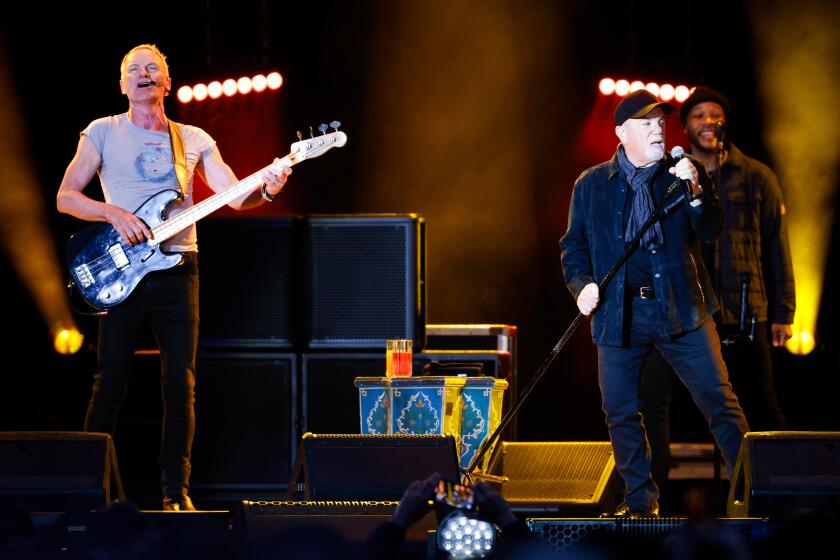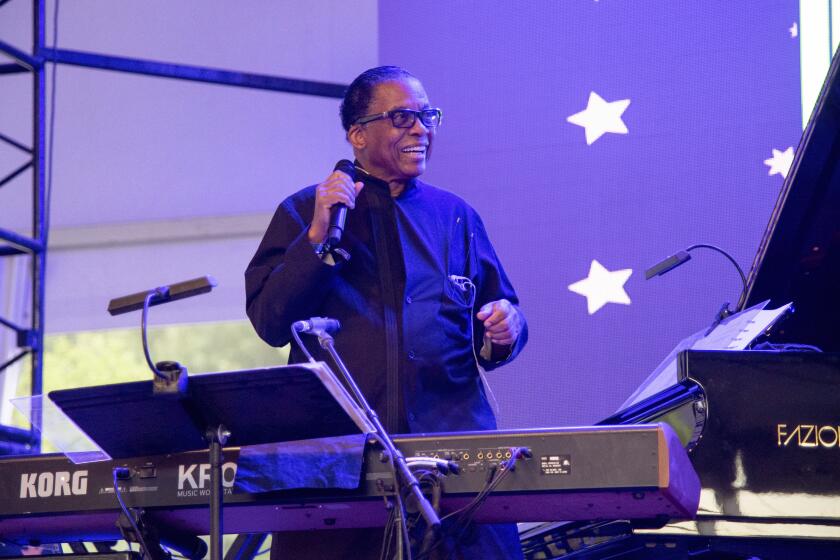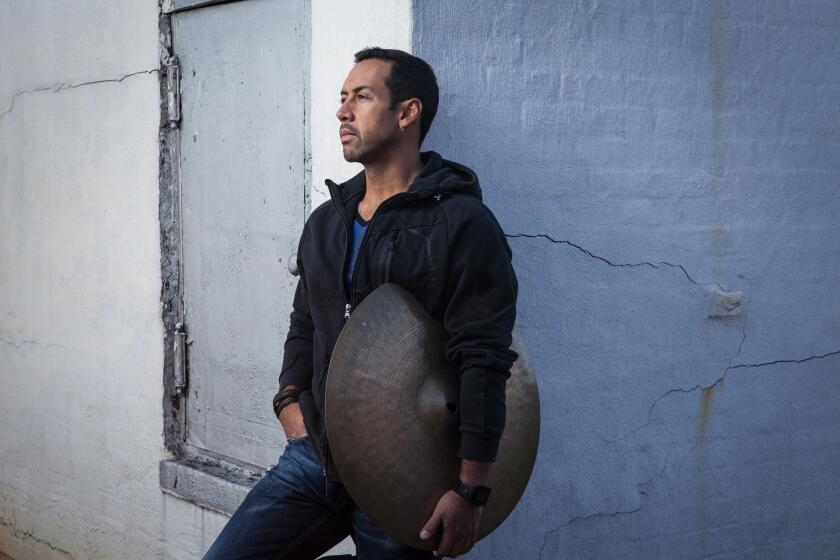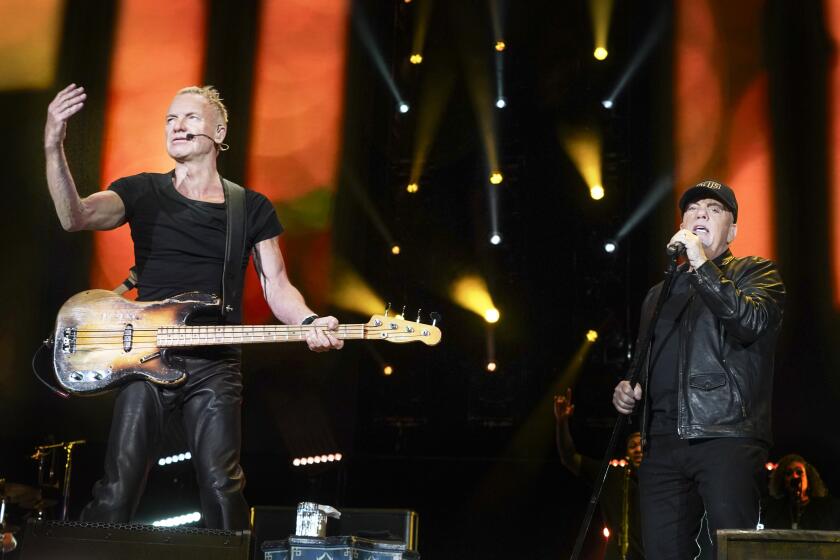Coachella Day 3: Festival wrap-up
Arcade Fire’s leader lashes out at the event’s VIP offerings, as first weekend of the sold-out fete concludes. Has Coachella grown too large or elitist?
Arcade Fire leader Win Butler didn't mince any words late Sunday when his band performed a propulsive headlining set, which included cameos by Blondie singer Deborah Harry and New Orleans' Preservation Hall Jazz Band, at the Coachella Valley Music & Arts Festival.
"We've been coming here for a lot of years and we're honored to be headlining. Thanks for supporting us," the California-born, Texas-raised, Canadian-based Butler told the cheering, overflow audience.
"I just want to say that there's a lot of fake VIP room bull---- happening at this festival, and sometimes people dream of being there – but it sucks in there, so don’t worry about it."
Butler's target was just one aspect of Coachella's growing focus on high-priced amenities at the festival, which last year drew upwards of 90,000 people per day, 20 percent of whom reside in San Diego County.
This year's edition, which begins its second weekend on Friday at the Empire Polo Club in Indio, sold out in less than three hours. It did so even though only one of the performers (OutKast, one of three headliners) had been disclosed at the time. The other 2014 headliners are Muse and the Butler-led Arcade Fire. All told, more than 180 acts performed over the past three days. The same lineup will be featured next weekend.
Coachella's current amenities include, at the upper end of the scale, a package that offers furnished, air-conditioned tents with a private swimming pool and concierge, plus two Coachella VIP weekend passes (cost: $6,500 for two). There are $799 VIP packages that include on-site cocktail bars. New this year are nightly gourmet wine dinners, held in a private rose garden ($225 each).
Coachella 2014
- Cameos by Beyoncé, Jay Z
- Coachella: OutKast's uneven return
- Head and the Heart groove
- The war on flower crowns
- Heavy metal kids
Complete coverage of the 2014 Coachella Valley Music and Arts Annual Festival
Of course, this is hardly the only festival that seeks to entice those fans who are willing to pay more for perks and greater comfort. And Coachella is constantly expanding the size and quality of its camping area for general admission attendees, adding an array of free entertainment options within the low-priced campground itself.
"Having more land for camping and parking is all part of making the festival a success, based purely on the fact people go and have a good time and are not shoe-horned into a tiny asphalt lot and told to camp there," said Gary Bongiovanni, the publisher of the leading concert industry magazine Pollstar.
Coachella was launched in 1999 by the Los Angeles-based Goldenvoice and was headlined by Beck, who returned Sunday night to deliver a terrific set.
The festival lost $750,000 that first year, went dark the next, and returned in 2001, pared down from two days to one (and only after Goldenvoice partnered with AEG, the world's second largest events and live music production company). AEG now owns a controlling interest in San Diego's Valley View Casino Center and exclusively books the 33-year-old Humphreys Concerts by the Bay series.
Coachella grew slowly, taking several years to draw a large enough audience to break even. Since 2007, when it expanded from two days to three and eliminated single-day tickets for weekend packages, it has grown and changed markedly. That was the same year, incidentally, that Arcade Fire performed at Coachella for the second time in two years and that VIP passes were introduced. (A full review of the band's Sunday show will appear here later Monday.) In 2011, Arcade Fire co-headlined the festival for the first time, along with Kanye West and Kings of Leon.
Where Coachella once appealed primarily to hipsters, who eschewed mainstream music for cult acts and uncompromising young and established artists with a demonstrable sense of daring, it now draws a much broader audience. It also mixes in more mainstream performers, be it Top 40 pop king Pharrell Williams, who energetically performed to a huge crowd Saturday, or (in previous years) Madonna, Prince and Paul McCartney.
On Sunday, Justin Bieber joined Chance the Rapper for one-song -- a cameo that may have been designed with an eye toward broadening Bieber's thus far non-existent indie cred.
The troubled teen-pop sensation could surely have benefited had he been on hand to hear some of this weekend's standout acts (and -- who knows? -- maybe he was). Some of those acts are new and some well-established, while a few have recently reactivated after decades of dormancy.
Friday's standouts included Ellie Goulding, Broken Bells, Aloe Blaacc, Russian DJ and producer Nina Kraviz, Bryan Ferry and The Replacements.
Saturday produced memorable performances by the Pixies, Warpaint, The Head and The Heart, Laura Mvula, Queens of the Stone Age, Chvrches and a heavy metal trio of Brooklyn seventh-graders who call themselves Unlocking The Truth.
Sunday's lineup mixed such veteran acts as Motorhead and Fishbone with such hot young buzz acts as The 1975, Courtney Barnett, Rudimental and Disclosure.
The above list helps underscore how well Coachella is curated by Goldenvoice honcho Paul Tollettt, who co-founded the event and also created Stagecoach, the sold-out, eight-year-old country music festival that is held at the same Indio location and this year takes place April 25-27.
Tollett and his team have also made Coachella a showcase for eye-popping visual and performance art, which grows more impressive each year.
The success of the festival has inspired the launch of numerous others across the nation, each hoping to somehow emulate Coachella's success. It's a quest made more challenging by the fact that the pool of headliners has not grown nearly as fast as the festivals in need of top talent. Witness Friday's headliner, the reunited hip-hop due OutKast, who are set to perform at 40 other festivals in the coming months.
Ironically, the festival in Indio has in part become a victim of its own success, attracting Hollywood celebs and paparazzi, arguably at the expense of at least some displaced fans.
Coachella, undeniably, is bigger than ever. But the festival seems to have lost, at least for now, some of its edge and independent spirit. This weekend also saw some curious scheduling decisions, most notably having both Lorde and Pharrell Williams perform Saturday on the smaller of the festival's two outdoor stages. (Both drew huge crowds, which were much larger than those for concurrent sets by other acts on Coachella's larger outdoor stage.)
Likewise, Saturday's performance by the Australian duo Empire of the Sun attracted so many fans it was impossible to get close to the overflowing Sahara Tent, in which they played. This scene was repeated, with other acts, at each indoor and outdoor stage, all three days.
Not coincidentally, the city of Indio caps daily attendance at Coachella at 99,000. At times this weekend, especially after dark, it was difficult to move because of the mass of people.
Happily, the crowds were friendly and generally orderly. But, especially after dark, having so many bodies in one venue, even such a large, outdoor venue as Coachella, can lead to understandable concerns about crowd control, should something go wrong.
Are the festival's burgeoning VIP attractions that fueled Win Butler's ire during Arcade Fire's set the sole reason Coachella may be in need of a re-think? Certainly not.
But as a veteran of the festival, Butler knows better than most what's been gained and what's been lost at this panoramic event. And he knows what's at risk if this unique musical ship in the desert isn't righted, so that it can be free of the pitfalls that can come when vast commercial success starts to overwhelm artistic considerations, diluting the vital sense of community that's played such a key role in making Coachella so uniquely, well, Coachella.






